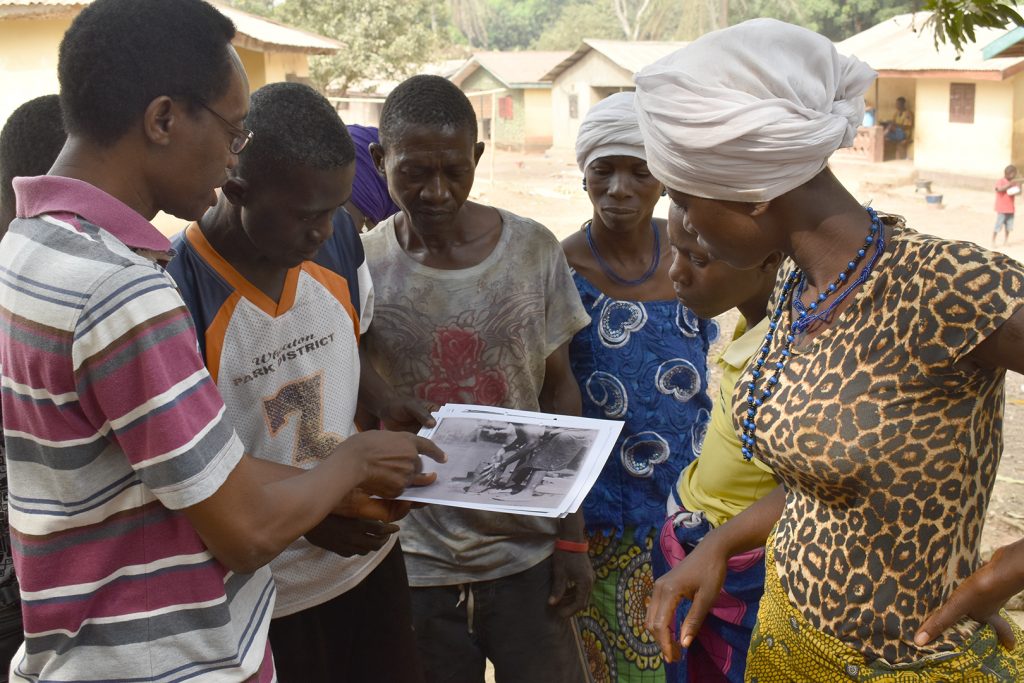
As part of the [Re:]Entanglements project we have been using art and creativity as methods of re-engaging with the anthropological archives assembled by Northcote Thomas in West Africa in the early twentieth century. This has involved developing many wonderfully rewarding collaborations with Nigerian and Sierra Leonean artists. Much of the resulting work has been displayed at exhibitions in Benin City, Lagos and Nsukka.
One of the artists we have been working with in Sierra Leone is Sheku Shakalearn Mansaray. Shakalearn grew up in a village in the Eastern Province of Sierra Leone, but came to Freetown in 1990. He comes from a family of artists and developed his skills as a carver partly through an apprenticeship and partly through formal training at Milton Margai College of Education and Technology. He is coordinator of an NGO called Peacelinks, which uses art and performance to promote peacebuilding and social mobilization especially among young people.

Shakalearn chose to engage with a series of photographs Northcote Thomas made in 1914 documenting pot-making in the town of Kamalo in present-day Sanda Loko chiefdom in the Northern Province of Sierra Leone. Thomas created a number of these photographic series during his Nigerian and Sierra Leonean tours. Each image in a sequence recorded a different stage in a process: the stages in a manufacturing process, for example, or a ritual. From a sequence of 15 photographs showing stages in the production of earthenware pots in Kamalo, Shakalearn selected eight to reproduce in his carved panel.

Rather than carving on newly cut timber, Shakalearn salvaged planks from an old Creole ‘board house‘ that was being demolished in Freetown. These beautiful wooden houses, built during the 19th century, were once common in Freetown. Unfortunately, many have fallen into disrepair and they have gradually been knocked down to be replaced with modern concrete structures. When Northcote Thomas visited Freetown during his 1914-15 tour of Sierra Leone, these houses would have predominated.
After rescuing the old timbers and cutting them to size, Shakalearn created a composite drawing of the eight different photographs on paper. He then chalked this onto the wooden panel and began to chisel out the work in relief. Normally Shakalearn’s carved works are given a much more fine finish. On this work, however, Shakalearn wanted to retain the aged patina of the salvaged boards. One inspiration was the work of the African-American artist Whitfield Lovell.



Clay pots were an everyday item used for storage and cooking, and were once made throughout Sierra Leone. Today, these sustainably-sourced and locally-manufactured pots have been displaced by imported plastic and metal utensils. There are, however, a few traditional potters still practicing in Sierra Leone. Most notable is the pot-making community at Mabettor near Lunsar in present-day Buya Romende chiefdom in the north of Sierra Leone.
In 2019, as part of our fieldwork for the [Re:]Entanglements project, we spent some time with the potters at Mabettor. We showed the community Northcote Thomas’s photographs of Sierra Leonean potters from 105 years before and left copies with them. A number of the potters, including Marie Sesay, Khadiatu Conteh, Adamsay Conteh, Isatu Koroma and Ya Abie Koroma demonstrated their pot-making techniques, which were exactly the same as those documented by Thomas in Kamalo. These day, however, their wares are mainly sold to visitors from overseas or Freetown who want them to decorate their homes.


We love the way Shakalearn uses traditional carving techniques to inscribe the archival documentation of another traditional craft form into wood salvaged from a building that would have stood at the time of Thomas’s anthropological surveys. Thank you Shakalearn!
A more detailed discussion of Northcote Thomas’s documentation of traditional pot-making and contemporary pot-making in Mabettor will be the subject of a future article.